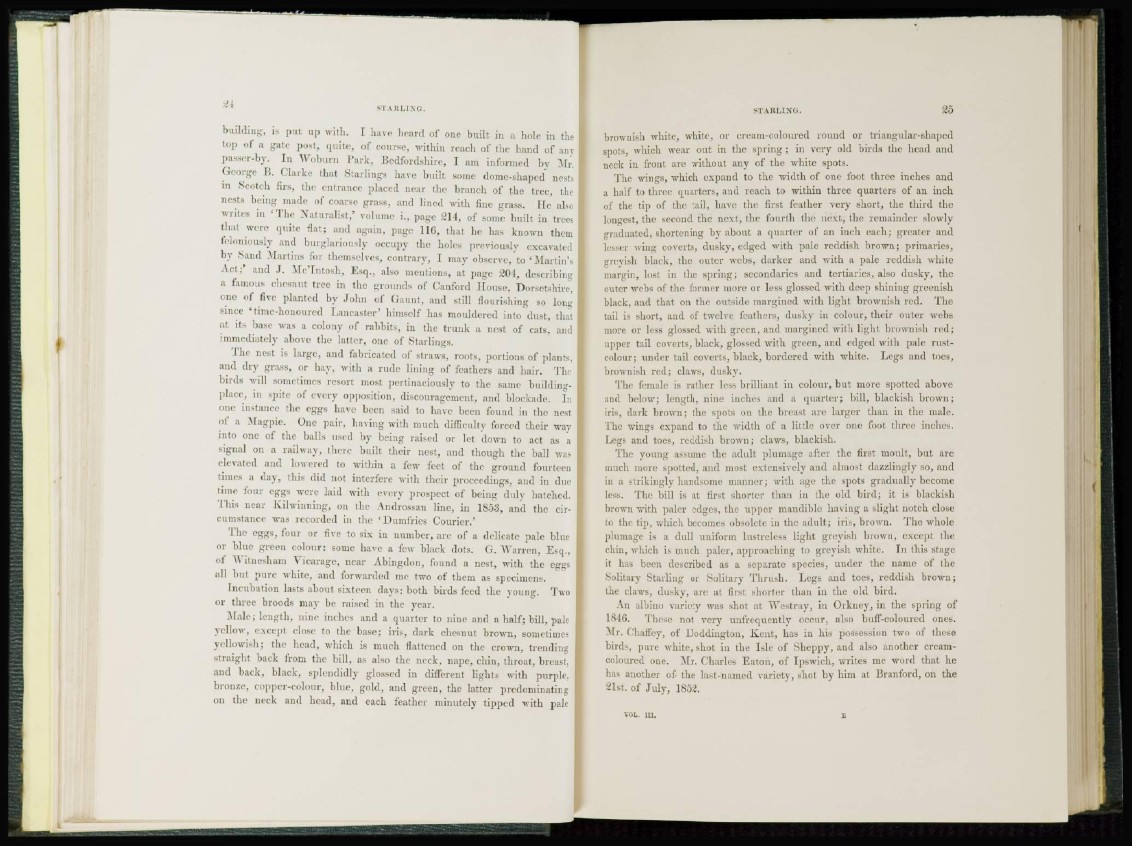
building, is put up with. I have heard of one built in a hole in the
top of a gate post, quite, of course, within reach of the hand of any
passer-by. In Woburn Park, Bedfordshire, I am informed bv Mr,
George B. Clarke (hat Starlings have built some dome-shaped nests
in Scotch firs, the entrance placed near the branch of the tree, the
nests being made of coarse grass, and lined with fine grass. lie also
writes in ' T h e Naturalist,1 volume i., page 214, of some built in trees
that were quite fiat; and again, page l l ( i , that he has known them
feloniously and burglariously occupy the holes previously excavated
by Sand Martins for themselves, contrary, I may observe, t o ' M a r t i n 's
Act;' and J. Mc'Intosh, Esq., also mentions, at page 204, describing
a famous chesnut tree in the grounds of Canford House, Dorsetshire,
one of five planted by John of Gaunt, and still flourishing so long
since 'time-honoured Lancaster' himself has mouldered into dust, thai
at its base was a colony of rabbits, in the trunk a nest of cats, and
immediately above the latter, one of Starlings.
The nest is large, and fabricated of straws, roots, portions of plants,
and dry grass, or hay, with a r u d e lining of feathers and hair. The
birds will sometimes resort most pertinaciously to the same buildingplace,
in spite of every opposition, discouragement, and blockade. In
one instance the eggs have been said to have been found in the nest
of a .Magpie. One pair, having with much difficulty forced their way
into one of the balls used by being raised or let down to act as a
signal on a railway, (here built their nest, and though the ball was
elevated and lowered to within a few feet of the ground fourteen
time's a day, this did not interfere with their proceedings, and in due
time four eggs were laid with every prospect of being duly hatched.
This near Kilwinning, on the Androssan line, in 1853, and the circumstance
was recorded in the 'Dumfries Courier.'
The eggs, four or five to six in number, are of a delicate pale blue
or blue green colour: some have a few black dots. (i. Warren, Esq.,
of AVitiiesham Vicarage, near Abingdon, found a nest, with the eggs
all but pure white, and forwarded me two of them as specimens.
Incubation lasts about sixteen days: both birds feed the young. Two
or three broods may be raised in the year.
Male; length, nine inches and a quarter to nine and a half; bill, pale
yellow, except close to the base; iris, dark chesnut brown, sometimes
yellowish; the head, which is much flattened on the crown, trending
straight back from the bill, as also the neck, nape, chin, throat, breast,
and back, black, splendidly glossed in different lights with purple,
bronze, copper-colour, blue, gold, and green, the latter predominating
on the neck and head, and each feather minutely tipped with pale
brownish white, white, or cream-coloured round or triangular-shaped
spots, which wear out in the spring ; in very old birds the head and
neck in front are without any of the white spots.
The wings, which expand to the width of one foot three inches and
a half to three quarters, and reach to within three quarters of an inch
of the tip of the tail, have the first feather very short, the third the
longest, the second the next, the fourth the next, the remainder slowly
graduated, shortening by about a quarter of an inch each; greater and
lesser wing coverts, dusky, edged with pale reddish brown; primaries,
greyish black, the outer webs, darker and with a pale reddish white
margin, lost in the spring; secondaries and tcrtiaries, also dusky, the
outer webs of the former more or less glossed with deep shining greenish
black, and that on the outside margined with light brownish red. The
tail is short, and of twelve feathers, dusky in colour, their outer webs
more or less glossed with green, and margined witli light brownish red;
upper tail coverts, black, glossed with green, and edged with pale rustcolour;
under tail coverts, black, bordered with white. Legs and toes,
brownish r e d ; claws, dusky.
The female is rather less brilliant in colour, but more spotted above
and below; length, nine inches and a quarter; bill, blackish brown;
iris, dark brown; the spots on the breast are larger than in the male.
The wings expand to the width of a little over one foot three inches.
Legs and toes, reddish brown; claws, blackish.
The young assume the adult plumage after the first moult, but are
much more spotted, and most extensively and almost dazzlingly so, and
in a strikingly handsome manner; with age the spots gradually become
less. The bill is at first shorter than in the old bird; it is blackish
brown with paler edges, the upper mandible having a slight notch close
to the tip, which becomes obsolete in the adult; iris, brown. The whole
plumage is a dull uniform lustreless light greyish brown, except the
chin, which is much paler, approaching to greyish white. In this stage
it has been described as a separate species, under the name of the
Solitary Starling or Solitary Thrush. Legs and toes, reddish brown;
the claws, dusky, arc at first shorter than in the old bird.
An albino variety was shot at "Westray, in Orkney, in the spring of
1846. These not very unfrequently occur, also buff-coloured ones.
Mr. Chaffey, of Doddington, Kent, has in his possession two of these
b i r d s pure white, shot in the Isle of Sheppy, and also another creamcoloured
one. Mr. Charles Eaton, of Ipswich, writes me word that he
has another of- the last-named variety, shot by him at Eranford, on the
21st. of July, 1852.
VOL. III. L